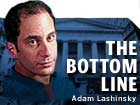
PALO ALTO, Calif. (CNN/Money) -
There's a good lesson in FleetBoston's decision last week to close down Robertson Stephens -- and that lesson is that FleetBoston made its courageous decision even though it had acquired Robby Stephens for about $800 million just four years ago.
In the financial world, FleetBoston's decision is a classic example of a "sunk-cost" analysis, and investors with portfolios a tiny fraction of Fleet's assets should take note.
Sunk costs are those that already have been made: The factory already built, the used automobile already purchased, the nonrefundable airline ticket already paid for. Though relevant for historic analysis -- here's the important part -- the sunk costs have absolutely nothing to do with a decision about whether to hold on to an investment or to invest more in it.
To wit, if the factory is turning out parts for a market that doesn't exist anymore, it's not worth improving the production quality of the machines. If the car's a lemon, and it costs more to fix than to buy a new one, then it's not worth repairing. (That's not taking into account any emotional attachment to the car, a relevant but not a financial consideration.) If the vacation is going to cost more than you can afford at the other end -- in hotels, meals, time away from work, etc. -- then it's cheaper to not use the airplane tickets.
And, to bring it back to the news, FleetBoston decided that its sunk-cost investment in Robertson Stephens didn't justify further losses or further obligations to its management after a sale.
What all this means to you...
Now, it should be obvious where this painful exercise is going. Namely, just because you purchased shares of a stock at significantly higher values doesn't mean you should hold on until the price returns. In fact, the price you paid has nothing to do with it, except, of course, for tax purposes.
Many of us are asking this precise question, including a reader who wrote in this morning about his shares in various Janus funds. "It is now worth less than half of what it was worth. Do you feel Janus (which is doing really badly) will come back? I am very seriously thinking of taking what is left and cashing it in."
| |
 RECENTLY BY ADAM LASHINSKY
RECENTLY BY ADAM LASHINSKY
| |
| | |
| | |
|
I can't tell anyone where the Janus funds are going or what to do with their money. The key is recognizing that the lost value is a sunk cost. So now ask yourself, would you invest more money today? If not, why are you holding on? And in what time frame do you expect to earn your money? And do you have alternatives for your investment? (If picking stocks no longer seems so easy to you, maybe it's time to consider an index fund.)
These are not easy questions. And this certainly is not an article suggesting that you sell. You may conclude the stock in question is a steal and buy more. My purpose merely is to make the painful point that clear-eyed professionals understand too well, that your past mistakes, horrible though they are to contemplate, aren't relevant in your decisions today.
Robertson Stephens addendum
Owners of funds run by RS Investments should check out the San Francisco firm's Web site for a reassuring message about its status. Yes, it was begun as a unit of Robertson Stephens in 1981. No, it's not part of Robertson Stephens today. Therefore, investors aren't affected by the closure of the investment bank. That's not to say RS Investments is in such great shape. As of June 30 its assets under management were $5.1 billion, back to their 1997 levels and far below their 2000 peak of $8.7 billion.
Adam Lashinsky is a senior writer for Fortune magazine. Send e-mail to Adam at adam_lashinsky@timeinc.com.
Sign up to receive The Bottom Line by e-mail.

|

